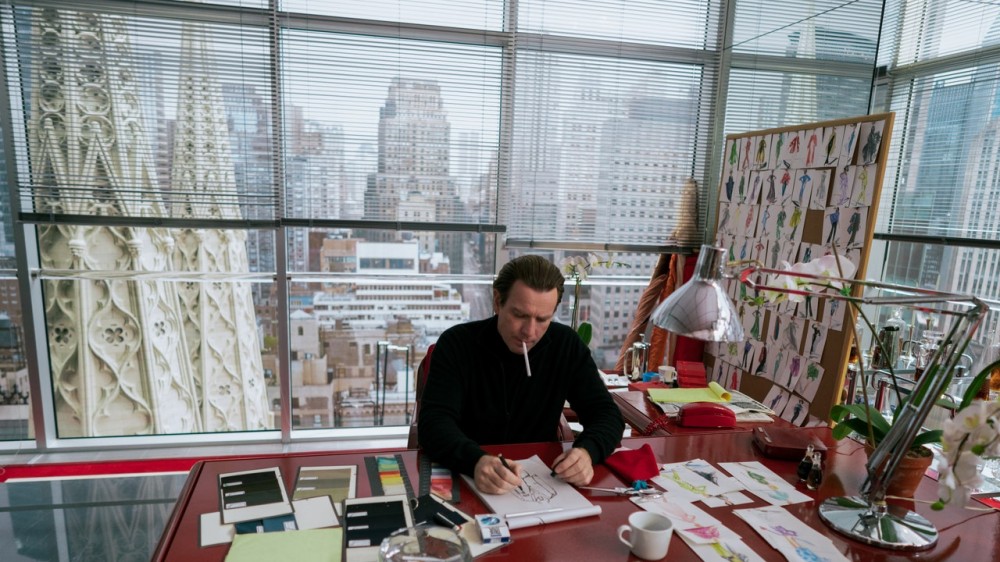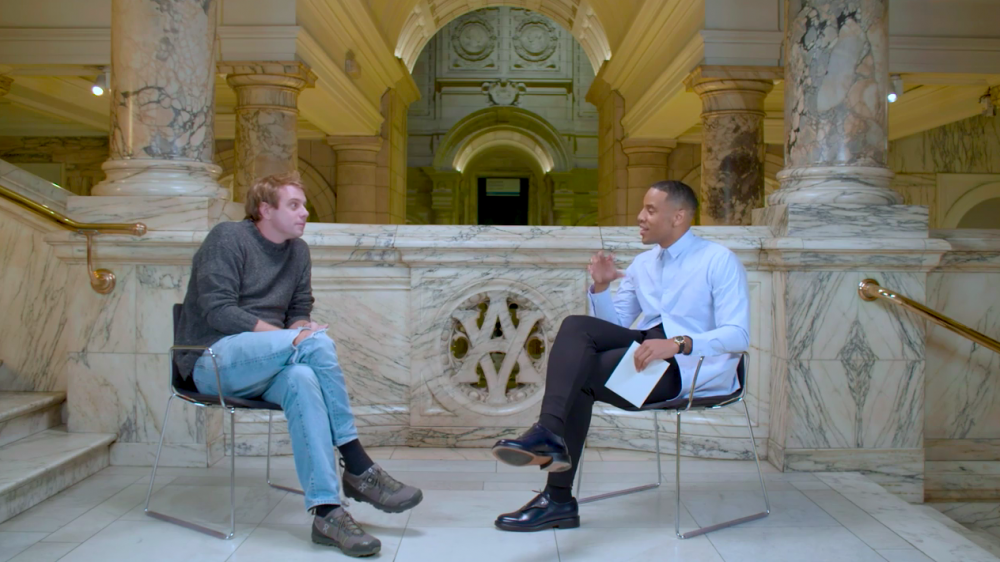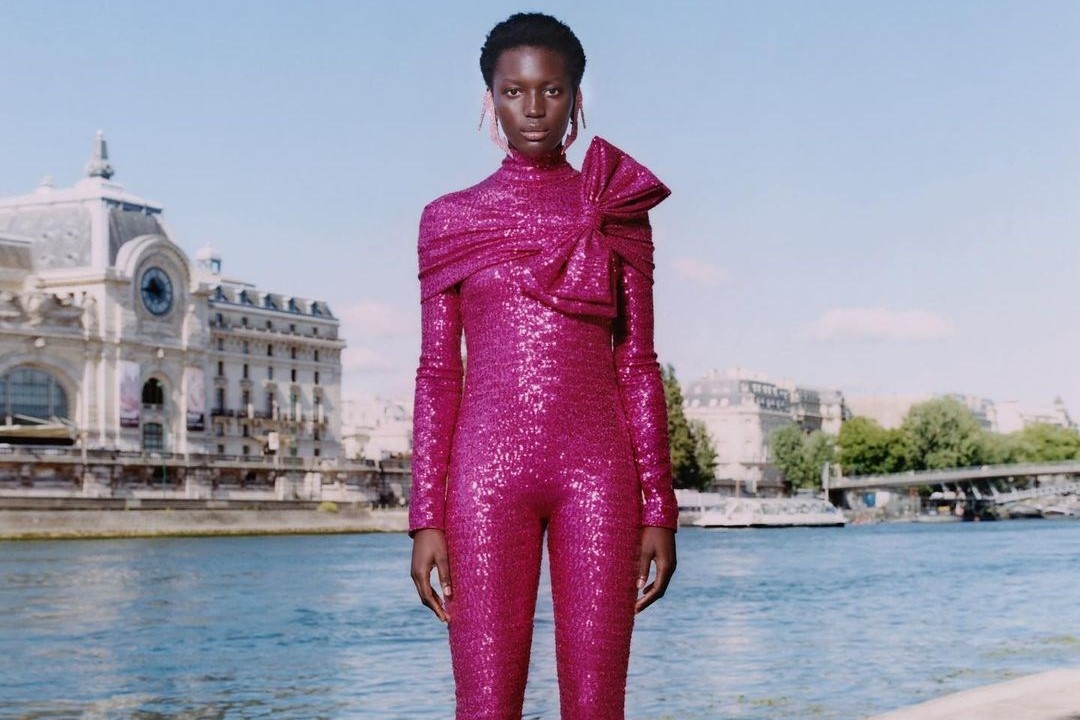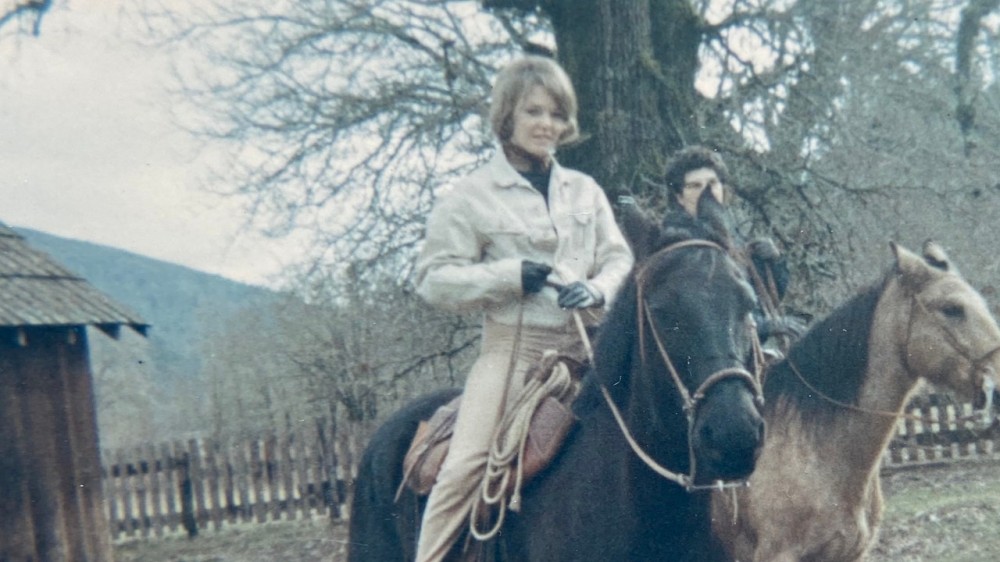
Style For Ages: Ryan Murphy Talks All Things Halston—Including His New Series—With Tom Ford and Hamish Bowles
To listen to this interview, click the play button below:
Roy Halston Frowick was a boy raised in Indiana who became a soaring fashion legend and an international household name that defined the heady Studio 54 era—until he burned out from drugs, poor business decisions, and, ultimately, AIDS. Ryan Murphy’s new Netflix series Halston, subtly directed by Daniel Minahan, casts a compelling Ewan McGregor as the complex designer. Hamish Bowles talks with Murphy and Tom Ford about Halston, those extraordinary years, and the crushing demands of design at the top.
Hamish Bowles: Ryan, what excited you about Halston and his story and made you feel this could be developed into a series?
Ryan Murphy: I grew up in Indiana—where Halston is from—surrounded by cornfields and churches, and I always heard about two people who had gotten out and gone on to bigger, glamorous things: One was Florence Henderson, and one was Halston. He was always a big figure in my mind—a representation of somebody who had come from humble beginnings and had gone on to do something incredible with his life—and I was always moved by him.
HB: Tom, when did you first become aware of Halston and his work?
Tom Ford: Well, a little bit the same: When I was a kid, my grandmother always had W, which then was a gigantic newspaper thing, and so I was very aware, as a 15-year-old, of who Halston was. You couldn’t not be aware if you cared about design at that time—I mean, the Ultrasuede, the wrap dress he did, the luggage for Hartmann. You couldn’t miss it. I moved to New York in the summer of 1979 and was lucky enough to just catch the end of that period.
RM: I have a book that has an amazing photograph, Tom, of you at Studio 54.
TF: Boy, I look horrible in that picture. That was some sort of 1920s party or something. My hair’s slicked back. I knew all those people—I can’t say we were best friends; I was an 18-year-old twinkie that was invited when somebody wanted extra cute boys around—but I did meet Halston a couple of times, and I went to his house once.
I was—to say “dating” is not quite right—with Fred Hughes, who worked with Andy [Warhol]. Fred was in his mid-30s, and I guess I was 18. But we would periodically date or sleep together or whatever you want to call it. And we went by Halston’s house to pick somebody up, and I walked in, and I remember just thinking, Oh, my God—this is exactly how I want to live.
So when that house came on the market a few years ago, a friend sent me a clipping. It had been redone by Gunter Sachs, who had bought it with Gianni Agnelli in 1990, [just before] Halston died. [Ford bought the house on East 63rd Street in 2019.] I’m redoing the top floor, mimicking Halston’s office [in Olympic Tower on Fifth Avenue], which you did so perfectly in your sets, all red on red on red on red, and mirror and mirror and mirror. I know all of that intimately—the sofas and everything. I’ve been copying those Halston sofas and chairs since I was at Gucci; I’ve copied them in my own stores.
RM: We spent a lot of time on that because it’s one of the things I admired about Halston—and about you: Your surroundings matter. You create a world, and people are invited to that world. You do that in your stores—I mean, one of the first things that I was obsessed with when I went into one of your stores for Gucci was your ability to curate an atmosphere that people want to be in. It’s the details. Halston did that.
Are you going to do [the house] exactly like Halston did it?
TF: Yeah, more or less. We have all of the original Paul Rudolph–designed furniture. I don’t want it to be a museum. It’s a great house—I’m really lucky to have it, it’s amazing that I have it, and I love it.
But back to your series: When I heard Ewan McGregor was cast, I have to say, I thought, Oh, my God, that’s completely wrong. But he got it so right. It’s incredibly convincing.
RM: He was, to us, the only choice. The thing that Ewan got about Halston was that Halston had a vision in his mind of who he wanted to be in life. He was self-created.
TF: Don’t you think everyone who is successful in that way invented themselves? I did. I’m sure you did, and Hamish, I know you did.
RM: One of the things that was repeatedly said to him was “You’re from Indiana. Why are you speaking like that?” In his mind, it was not affect—it was natural. I think Ewan got that. Ewan really connected with the pain of Halston and the longing of Halston, and how confusing it is to have to be an artist and a businessman at the same time. Other things as well—the power of a muse, for example.
TF: Oh, my God—your Elsa Peretti [actress Rebecca Dayan] is breathtaking, breathtaking. I thought that was one really great thing about the screenplay because I don’t know that most serious films about fashion really capture that: You really do get a sense that, yes, it was Halston, but it was also his entourage of people, including Joe Eula and Joel Schumacher. That depiction of the entourage and how important that is to Halston capturing the moment [when] it all just comes together: You captured that so well.
HB: This idea that a designer doesn’t spring fully formed—is that something that you found to be true in your own career, Tom?
TF: Of course. In the beginning, when Halston does his first ready-to-wear collection and it’s not a success—I mean, it takes you a while to figure out your voice and to figure out what you want to say. That’s true, I think, with musicians, with actors, with certainly directors and producers, writers—it can sometimes take a while to figure out who you are and what you have to say.
Do you know we’re all the same ages as when they all died? I mean, Halston was, I think, 57. Andy Warhol was 58; I’m about to turn 60. They didn’t live so long. Halston was really famous for maybe 10 years, max, and that’s kind of the way it works often with fashion designers. That moment you captured very well.
RM: We end with his death of AIDS [in 1990] and that idea of so many heroes and people being lost in that time—that informs a lot of my work.
TF: I don’t know what your personal experience with it is, but that is something that this generation will never, ever understand. I mean, I knew one of the very first people who had AIDS in 1981—when it was called “gay cancer.” [My husband,] Richard [Buckley,] and I—we’ve been together since ’86—on our first few dates I would go uptown to visit my friend who was dying in the hospital. He would go to a different hospital to visit his friend that was dying. It was just so brutal. You’d sit at a party and look across the room, and the light would hit a friend in a certain way, and you just…you knew. And the next time you saw them, of course, there was a sore on their face.…
Richard and I both had HIV tests at the time—they had not been around that long—and we both waited to see the results, and I remember Richard calling me, crying with joy that he only had cancer. It was stage IV, and he was like, “Oh, my God. I only have stage IV cancer,” which was better than having AIDS at that time. I kind of wish in a way that the current young generation could fully understand what that was. I don’t think there’ll ever be any way, because now you take a pill and it’s very different.
RM: So much of it was about shame. The tragedy of Halston was that he died pretty much alone. He was with his family, but he felt sort of exiled not just from the fashion world but from the entire world. One of the most moving things we have in the finale is one of his last acts: He bought a Rolls-Royce convertible and he had a driver, and he just went up and down the Pacific Coast Highway—for the first time in his life being inspired and not having to translate that inspiration into a collection.
HB: What was it, Tom, about Halston’s era, design-wise, that spoke to you—whether then or now?
TF: The thing I loved about that period was that it was minimalist, but it was tactile. If you pick up a Halston dress, they look very simple from the outside, but you could flip them inside out and they look exactly the same as they did from the front. They were so beautifully made. Everything at that moment in the sort of mid- to late ’70s was streamlined, but it was glamorous. It was marble or it was glass or it was fur or it was velvet. You touched anything, it felt very sensual—very sexual, even, though it looked very clean. That aesthetic for me is still my aesthetic today. It made such an impact on me.
RM: Me as well. It was always sort of the world that I wanted to live in. I grew up with Colonial furniture from Sears, but I would look at Halston stuff. It’s a way of being, and I’ve found that Halston was so interesting because his environment was so controlled while his creativity was so chaotic. I think the mixture of those two things is fascinating.
TF: Well: The drugs. Do you know that is something that still, to this day, really permeates the fashion industry? I had a drug-and-alcohol problem, and when I was at Gucci, when the brand was just cranking out cash and we were doing billions of dollars a year, people started catering to every little thing I wanted. There was always cocaine on the desk, and everyone’s telling you that you are amazing. A lot of fashion designers do not survive that. So [your] depiction of those kinds of temper tantrums and shortness with people, all of that—at least in my own personal experience—was very accurate. And of course it was accurate for Halston.
HB: Ryan, it’s very unflinching, your approach. As I understand it, this is a project that’s been in development for 25 years. Do you think you could have been as unflinching in the early days of the genesis of this?
RM: No, I don’t. Television has changed a lot, particularly in the streaming world. I used to spend half my career fighting with standards-and-practices about “Why can’t I show this? Why can’t I do this?” It was always about sex, too—it was never about violence. But we never had a single note about any of the sexuality or the depiction of drug abuse—to me, they went hand in hand with the piece. So we were able to make something that was, I felt, really accurate.
TF: I felt the sex was very tame.
RM: You did?
TF: I mean, I’m sort of kidding, I’m sort of not kidding. I remember that balcony at Studio 54: You went up there to have sex. You’ve got that scene where Victor [Hugo, Halston’s lover, played by Gian Franco Rodriguez] is having sex with a guy and Halston looks up and sees it: totally, totally, totally accurate.
RM: It was interesting when we were researching it because Halston, I think, used drugs and sex as a release from the pressure, from the creation, from the worry of having the lights turned off, and we made sure to dramatize that. Many creative people burn out from too much sex, too much drugs or alcohol, too much pressure. So we wanted to be careful to make that part of his creative experience. I was really interested in the fact that the one big love affair of his life was with Victor Hugo. He really did try and make a romantic go of that until Victor basically let him know that that wasn’t going to happen. Once that happened, he just became an out-of-control personality where anything and everything was available to him. He really wasn’t able to pull out of that.
HB: Tom, what else do you think we can learn from Halston—from the arc of his career, from his talent, and maybe the mistakes?
TF: Remember: This country was founded by Puritans, and Americans have always been afraid of too much style. I lived for 30 years in Europe, and there is a totally different sensibility and a completely different sort of acceptance of style. That American sensibility—that pared-down, almost no jewelry, no ornament, no bows, no anything. . . . It’s about catching the zeitgeist and finding the right time. That sensibility at that moment in time, worldwide, was the right thing. That, to me, is what he was able to capture.
RM: Has there ever been a particular period of your life that was most influenced by Halston?
TF: Probably the mid-’90s. I did these white, very simple dresses with cutouts in different parts of the body. Elsa Peretti–esque hardware that was set on the body and revealed by the dress. But I mean, I went to architecture school—Mies van der Rohe was my God, in a way. The thing about Halston is you get to have the severity of that minimalism, but you get that tactile luxe that you didn’t necessarily get with the ’20s and ’30s version of that minimalism. My urban aesthetic is very definitely still that kind of ’70s, very glamorous, slick, lacquer, glass, luxurious minimalism.
RM: I feel the same—I never got away from that influence that I loved when I was 13, 14, 15.
TF: You don’t. The first time you see beautiful things when you’re growing up, I think that aesthetic stays with you. The very first time you see a beautiful house, a beautiful apartment that moves you, a beautiful woman or a beautiful man, that forms [you]—the same way that food you ate as a kid does. I mean, give me a Hostess Twinkie and I’m pretty happy, still to this day.
But back to influences: I mean, the Battle of Versailles! [The so-called Battle of Versailles, a glamorous fundraiser held in 1973 and organized by PR doyenne Eleanor Lambert and Versailles curator Gerald Van der Kemp, pitted Parisian haute couture designers against a quintet of American designers, including Halston, with a performance by Liza Minnelli and a cabine that featured 10 Black models.] Liza’s performance, and at that moment of her career—it wasn’t so much the clothes, it’s who’s wearing the clothes and what they’re doing in the clothes. I’m not taking anything away from the clothes—I’m just saying that when I have a show, I think very much about the theater of it. What is the music? How does it feel? How does it look? What world are you creating? That world that you created in that episode. . . . I liked that you had Joe Eula painting the Eiffel Tower because of course, famously—in the fashion world, everybody would know it—he had made it all the wrong size. I thought it was brilliant.
RM: One of the things I love the most about that sequence, and indeed the entire performance, was about the relationship between Halston and Liza [played in the series by Krysta Rodriguez]. It’s in her kindness and his kindness toward her, and sticking with someone through thick and thin. That was the heartbeat of the piece. Before we shot, Ewan met Liza and talked to her about Halston, and it was a very private conversation but a very emotional, heartfelt one. I’m glad that we get to bring that relationship forward because I think people forget about that and how both of them were such amazing powerhouses at that time.
People also forget this about Halston, but he was one of the first to demand African-American models in all of his shows, which at that point was really not done. He demanded it and nurtured many of those relationships with women like Pat Cleveland. He was so vanguard.
TF: Pat Cleveland used to twirl down the runway. I was lucky enough to photograph Pat myself, and I felt like I was taking cocaine again. I left after shooting her for three hours, and I just thought, Oh, my God—this is why everyone wanted to work with her. She has this amazing energy. Back then, fashion models smiled, and they looked joyful in the clothes. They didn’t look miserable and depressed in their $30,000 dresses.
RM: I think we worked really hard to show a full portrait of not just a fashion designer but what it’s like to be an artist—and the temptations of that, and the temptations when the world tells you, Yes, yes, yes, yes, yes. And then, suddenly, a real hard no.
TF: Let’s hope we never get that hard no, Ryan.
RM: Never a hard no.
TF: Never.



